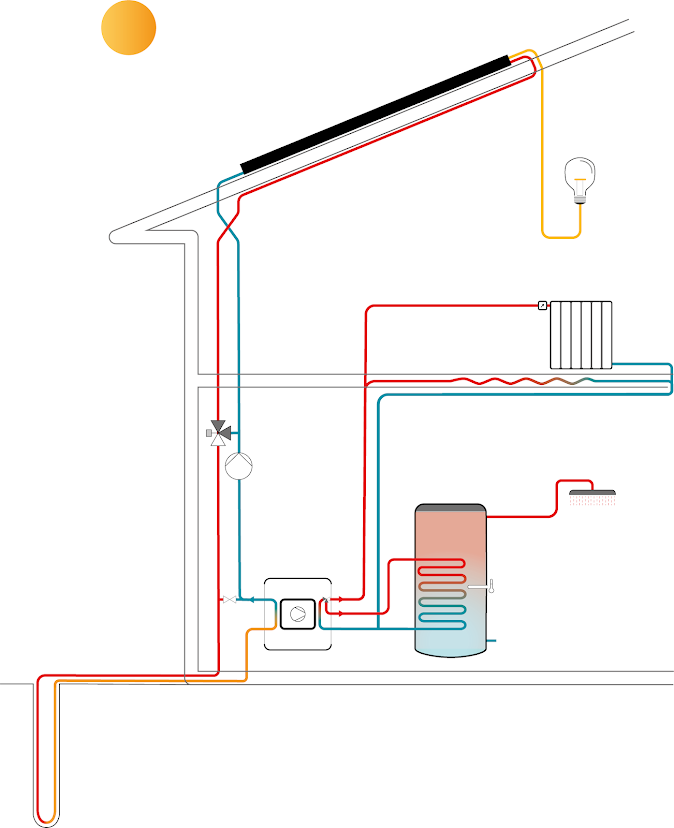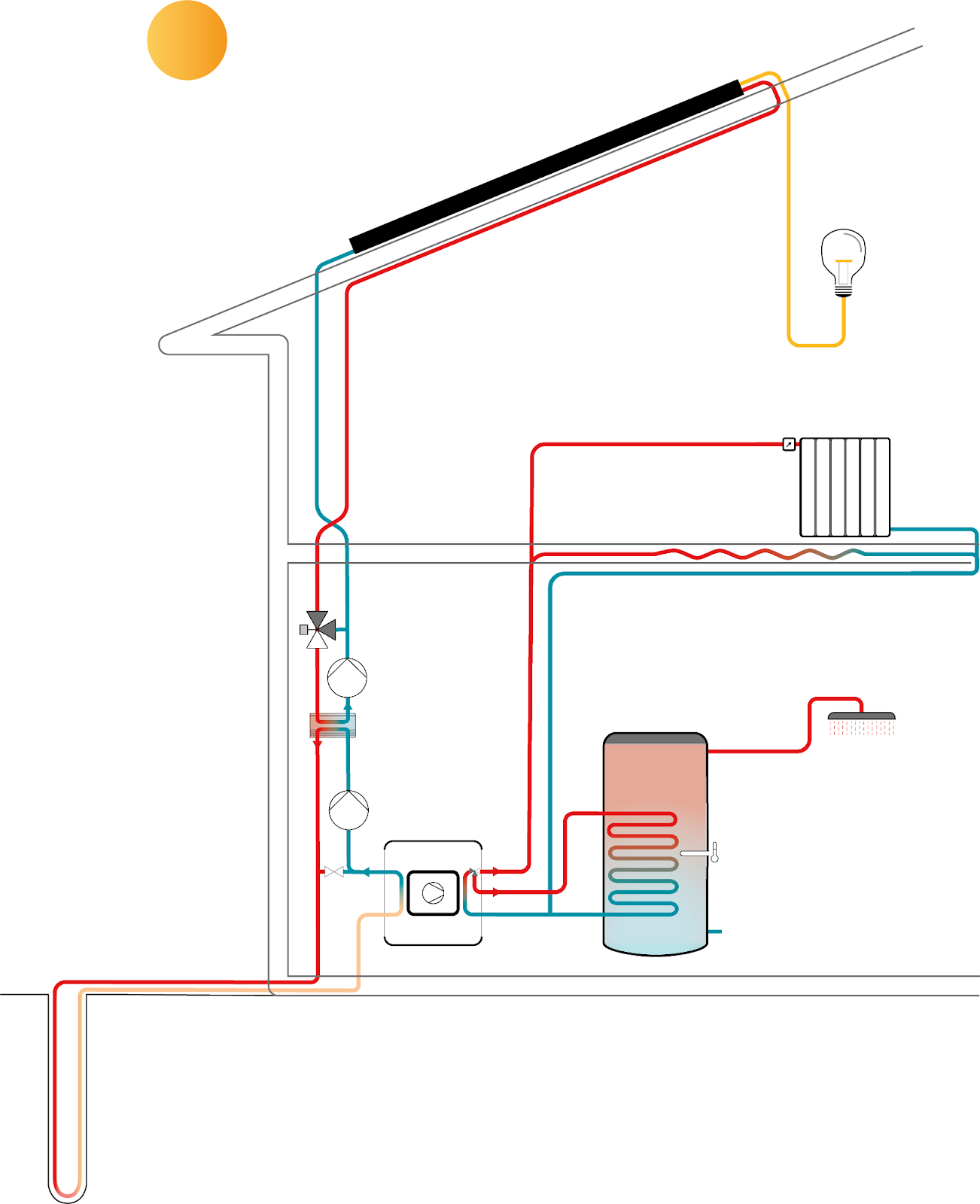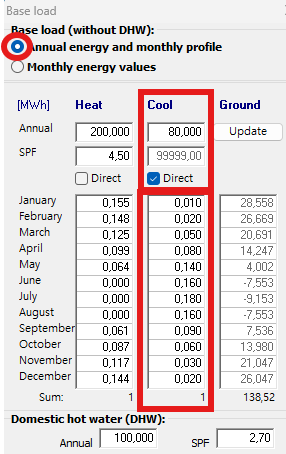Can Dualsun SPRING panels be connected to a geothermal installation?
Yes, Dualsun SPRING4 non insulated panels are designed to be coupled with geothermal heat pumps to recharge the geothermal storage with the sun's energy which significantly improves the heat pump performance.
How does the system work ?
The most common geothermal source is boreholes which are drilled between 100 and 400 m. In installations with undersized or many neighboring boreholes the subsoil does not necessarily recharge with enough thermal energy during the summer.Thus, from winter to winter, a geothermal heat pump loses efficiency.
To overcome this problem, Dualsun SPRING panels can be connected to geothermal probes to recharge the ground with thermal energy.
The solar thermal energy is injected in the brine circuit to recharge the ground source and significantly improve the performance and power output of the geothermal heat pump and thus achieve a very high energy coverage of buildings.
In winter, when the heat pump produces domestic hot water and heating, the hybrid solar panels cover part of its electricity consumption and improve its performance by preheating the coolant in the cold primary circuit.
In summer, when the heat pump produces domestic hot water or pool heating, the hybrid solar panels boost the efficiency and cover a greater part of its electricity consumption. When the hot water needs are satisfied, the excess heat generated by the hybrid panels recharge the geothermal source and makes it more efficient next winter.
And moreover the photovoltaic cells are all the time cooled which boost the yearly electricity production by up to 10%.
How to connect the panels to the geothermal system?
Two main configurations are possible depending on the project:
without heat exchanger for small projects if the primary loop is filled with a compatible antifreeze
with heat exchanger for big projects or if the primary loop is not filled with an antifreeze (e.g. glycol)
In both configurations, a mixing valve is necessary at the outlet of the solar field to avoid too high temperatures in the brine circuit. The temperature limit depends on the regulations in force in each country (30°C in Scandinavia, 40° in France).
Hydraulic layout without heat exchanger
Hydraulic layout with an heat exchanger
In many cases the PVT panels are placed in a dedicated hydraulic circuit, separated from the borehole and evaporator circuit (brine). The reason for this can vary, but here are some of the main reasons:
Different frost protections in the two circuits. I.e in the Nordic countries bioethanol is the most common frost protection in a borehole circuit which can not be used in PVT panels.
Pressure difference. i.e. if the height between the roof and technical room are too big the static pressure head will be too high for the borehole and solar circuit.
Redundancy. I.e. Service activity in the solar circuit will not hinder the heat pumps to work.
In all yield estimations and sizing guidelines (PVT panels per kW of HP) circuit separation with a heat exchanger is assumed to be used.
See How to size the heat exchanger ⬇️
How to size an installation?
For system up to 3 boreholes
We recommend to take the highest number of PVT panels of the following 2 calculations :
0.4 hybrid panel per kW of rated heat pump output (B0W35)
1 hybrid panel per 10 meter of missing borehole depth (up to 30% of correctly dimensioned borehole)
For a ground recharge of 100%, we can anticipate approximately 1 m² of hybrid panel for 5 m of geothermal borehole. More accurate sizing is to be done imperatively by a design office which will take into account the characteristics of the soil and the project.
For system with more than 3 boreholes
For some types of frequently occurring projects, where GSHP are covering 95-100% of the yearly thermal energy and land area for boreholes is not a limiting factor it is possible to give some simplified sizing guidance.
Requirements for borehole storage formation:
borehole distance = 20 meters
not more than 2 borehole wide formation (little impact of number of boreholes in length direction)
Apartment building: 0.3-0.6 SPRING4 panel per kW of heat pump output power.
Requirements:25-50% domestic hot water
50-75% heating
No cooling
With a high share of domestic hot water and low heat pump power coverage the higher amount of SPRING4 panels are recommended.
With a low share of domestic hot water and high heat pump power coverage the lower amount of SPRING4 panels are recommended.
Industrial building: 0.2-0.3 SPRING4 panel per kW of heat pump output power.
Requirements:<5% domestic hot water
>95% heating
No or small amount of cooling
However many projects are outside the limit of this simplified sizing or are worth to calculate in more detail, we have therefore provided an advanced sizing guidance below.
Pool heating with geothermal heat pump
If the geothermal heat pump is to be used for seasonal outdoor pool heating, a larger number of PVT panels are recommended to be installed.
The recommendation is to increase the amount of PVT panels with 0.1-0.3 PVT panels per m² pool area from the recommendations above.
0.1 PVT panels per m² pool area for a well-insulated pool with cover
0.3 PVT panels per m² pool area for a poorly insulated pool and without a cover.
If the ground source heat pump is used for heating an indoor pool (year around), the thermal energy demand of the pool can be considered as domestic hot water in the sizing recommendation above.
In combination with cooling
In case of boreholes storage is used for cooling as well the combined recharge of thermal energy from PVT and cooling are to be used.
In case of passive cooling, the cooling shall have priority and be hydraulically placed before or in parallel with PVT. In case borehole temperatures are getting too high for the passive cooling the PVT recharge can be paused until temperatures drop back.
How to size a heat exchanger for circuit separation in a geothermal installation?
The sweet spot in design (maximum) flow rate for SPRING4 in geothermal heat pump applications is found in the range of 100-150 l/h per panel.
The following design parameters are recommended to use when sizing the circuit separating heat exchanger in a geothermal installation with SPRING4 couple to the brine circuit:
Primary side (solar) | |
Flow rate | 125 l/h per panel |
Inlet temperature | 8 °C |
Return temperature | 2 °C |
Pressure drop | < 20 kPa |
Fluid | Propylene glycol, 50% V/V or other approved frost protection |
Secondary side (borehole) | |
Flow rate | Free parameter (most likely in the range of 1.9 times the primary side flow rate) |
Inlet temperature | 0 °C |
Return temperature | 3 °C |
Pressure drop | < 20 kPa |
Fluid | Frost protection used in borehole |
How to simulate recharge of PVT in Earth Energy Designer (EED)?
For other larger geothermal systems simulation in softwares like Earth Energy Designer (EED) is recommended to provide good sizing of PVT panel amount. This is due to the many parameters to take into account:
Number of boreholes
Depth of boreholes
Distance between boreholes
Formation of boreholes
Geological at site
Temperature of undisturbed ground
Heat pump thermal peak load
Heat pump thermal energy demand per month
Cost of boreholes
Goal of simulation:
Reduce number of boreholes
Fit sufficient with boreholes in the available land area
Find optimal balance between PVT cost and bolehole savings
Simulation of SPRING4 panels in EED adding the annual energy in MWh from the SPRING4 panels as a “direct” cooling base load and an energy distribution representative for the project location.
PVT energy distribution in EED::
| Nordic |
Jan | 1% |
Feb | 2% |
Mar | 5% |
Apr | 8% |
May | 14% |
Jun | 16% |
Jul | 18% |
Aug | 16% |
Sep | 9% |
Oct | 6% |
Nov | 3% |
Dec | 2% |
What thermal yield can be expected from SPRING4 in GSHP systems
The thermal energy production per PVT panel is the following in Helsinki:
Thermal yield (MWh/year/PVT) | |
Recharge rate | Helsinki |
10% | 2.800 |
15% | 2.650 |
20% | 2.500 |
25% | 2.375 |
30% | 2.250 |
35% | 2.100 |
40% | 2.000 |
45% | 1.900 |
50% | 1.800 |
55% | 1.700 |
60% | 1.625 |
65% | 1.550 |
70% | 1.500 |
To find out more: Are Dualsun (PVT) hybrid panels compatible with water/water heat pumps?



